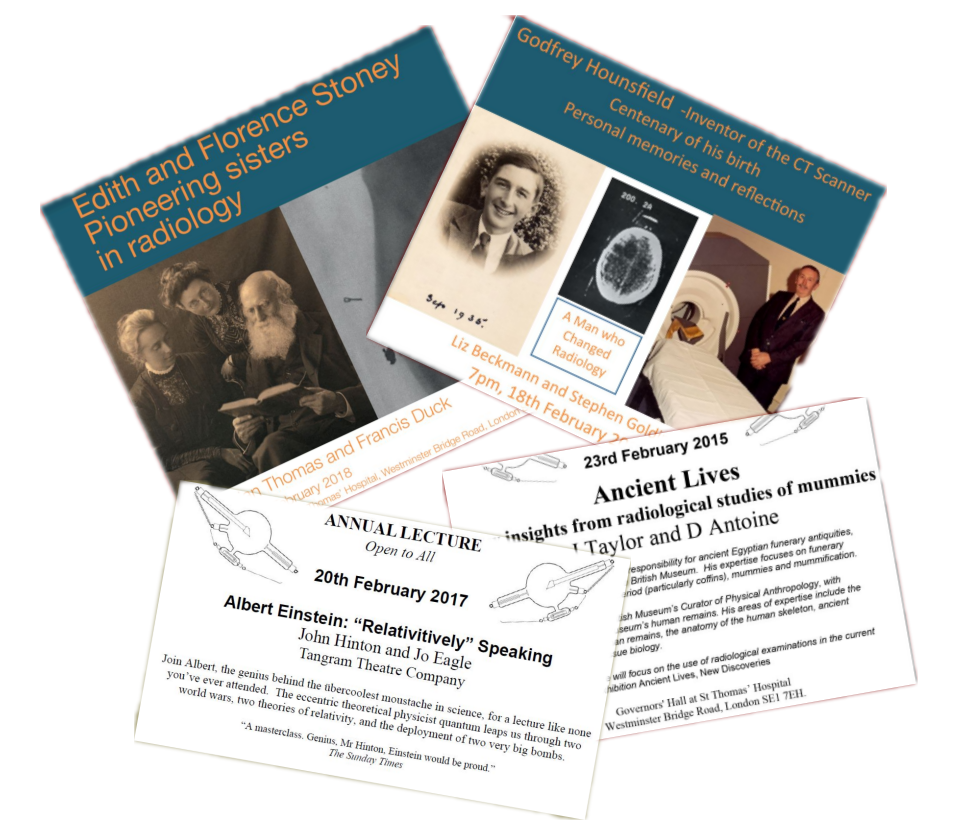- Details
- Category: Talks
CONFERENCES
History of Radiology Session UKRC 2017
History of Radiology Session UKRC Liverpool 2016
History of Radiology Session UKRC 2015
History of Radiology Session UKRC 2014
History of Radiology Session, BSHR/ISHRAD and BSHM, Canterbury 2013
Nervous Women: Two centuries of women and their psychiatrists. ISHRAD Symposium Oct 2012
Medical Physics… Francis Duck, ISHRAD 2014
ISHRAD, International Day of Radiology and the 120th anniversary of Rontgen’s discovery in Wurzburg.
- Details
- Category: Talks
| TALKS & CONFERENCES |
TALKS
BSHR ANNUAL LECTURE 2023
Watch the Annual Lecture video
Report of BSHR Annual Lecture 6 February 2023
Report by Dr Arpan K Banerjee Trustee and Council member and Former Chair Brit Soc Hist Radiology (BSHR)
The venue of this year’s British Society for the History of Radiology annual guest lecture on the 6 February 2023 was again the magnificent Governors' Hall at St Thomas’ Hospital, London. Geoff Meggitt a distinguished retired medical physicist delivered an illustrated talk entitled ‘Radiation Radicalism and Race :The Science and Politics of Hermann Muller’. Some readers may be aware that Geoff Meggitt wrote a well received biography of Muller in 2016.
The lecture started by setting the background to evolution with references to Darwin and Mendel. Muller the controversial scientist led a remarkable, often peripatetic, life. Muller born in the USA was of German origin and studied biology initially at Columbia University U.S.A. His real passion was genetics. The contributions of Thomas Morgan and his team in the now famous fly lab fired Muller’s enthusiasm and he became interested in Drosophila genetics and joined Morgan’s team to do research and co-wrote the book The Mechanism of Mendelian Heredity in 1915. Julian Huxley the famous biologist found him a job at the Rice Institute and Muller completed his PHD in 1916. He returned to Columbia in 1918 from where he moved to Texas.
In 1926 he made his famous discoveries of X-ray mutagenesis working with radiation which resulted in his Nobel Prize in 1946. His experiments with the crossing over suppressor stock(CIB) showed a relationship between the radiation dose and lethal mutations. In his Nobel Lecture he argued that the dose response curve for radiation induced tumours was linear with no threshold.
Muller’s time of exile in Europe in Germany, Russia, and Spain was described, his friendship with Edgar Altenberg was mentioned and his leftist leanings and controversies with his opinions on the Russian Lysenko were included. He even managed to anger Stalin.
Muller also had an interest in the controversial subject of eugenics and this topic was not given short shrift with a mention of his 1910 Peithologian (debating society) Lecture in Columbia where his ideas were first expressed.
He seemed to have struggled to get tenure all his life but eventually settled in Indiana, USA.
Muller was a complex character, brilliant prolific yet controversial scientist whose contributions and life were beautifully presented in this lecture and a lively audience debate at the end of the lecture concluded the evening.
BSHR Annual Lecture 2020
Mummies at the Museum, BSHR Lecture 2015
LIST OF LECTURERS
2006 Mme D. Zerroug-Lucbert
2007 Mrs Sally Milne and Mr Bryce Halliday
2008 Elizabeth Beckman
2009 Prof Frank A.J.L. James
2010 Prof Peter Ell
2011 Joseph Padfield
2012 Jim Thurston
2013 Prof Wade Allison
2014 Dr James Le Fanu
2015 Dr John Taylor and Dr Daniel Antoine
2016 Dr Allan Chapman
2017 John Hinton and Jo Eagle
2018 Prof Francis Duck and Prof Adrian Thomas
2019 Liz Beckman and Dr Stephen Golding
2020 Richard Price
2021 Dr Uwe Busch
2022 Dr Michael Jackson
2023 Dr Geoff Meggitt
2024 Prof Stephen Keevil
2025 Prof Marcel van Herk
CONFERENCES
UKRC Liverpool 2019
History of Radiology Session UKRC 2017
History of Radiology Session UKRC Liverpool 2016
History of Radiology Session UKRC 2015
History of Radiology Session UKRC 2014
History of Radiology Session, BSHR/ISHRAD and BSHM, Canterbury 2013
Nervous Women: Two centuries of women and their psychiatrists. ISHRAD Symposium Oct 2012
Medical Physics… Francis Duck, ISHRAD 2014
ISHRAD, International Day of Radiology and the 120th anniversary of Rontgen’s discovery in Wurzburg.


